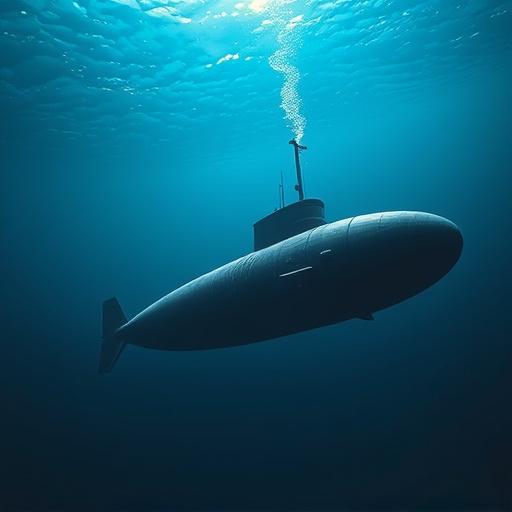Submarines have evolved from historical vessels to indispensable assets in modern naval warfare. This article explores the multifaceted role of submarines, delving into their design advancements, unparalleled stealth and strike capabilities, versatility in operations, and technological enhancements. From their origins to future prospects, submarines continue to shape underwater warfare, offering strategic advantages that are both dynamic and discrete. Discover how these underwater powerhouses adapt to meet contemporary military needs.
The Evolution of Submarines: From History to Modern Design
The evolution of submarines has been a fascinating journey, transforming from simple underwater vessels to sophisticated military assets. Historically, early submarines were often clunky and unreliable, with limited maneuverability and short operational ranges. These pioneers, like the iconic Turtle from the American Revolutionary War, laid the foundation for what would become a formidable naval warfare tool.
Over time, submarine design advanced significantly, incorporating improvements in propulsion, hydrodynamics, and weaponry. Modern submarines are marvels of engineering, featuring sleek and efficient designs that enable them to stealthily navigate the deep. They are equipped with cutting-edge sensors, advanced navigation systems, and powerful torpedoes or missiles, making them key contributors to naval power projection and intelligence gathering.
Unparalleled Stealth and Strike Capabilities
Submarines offer unparalleled stealth and strike capabilities, making them a formidable asset in modern naval warfare. Capable of operating deep below the waves, they can approach enemy targets undetected, launch precision strikes, and then disappear into the ocean’s depths—a level of discretion that is unmatched by surface ships. This furtiveness allows submarines to gather intelligence, monitor enemy activities, and conduct covert operations with minimal risk of detection.
Moreover, submarines are equipped with advanced weaponry, including torpedoes and cruise missiles, enabling them to engage in anti-ship warfare, minefield clearance, and even land attack missions. Their ability to operate autonomously for extended periods means they can patrol vast areas, ensuring a constant naval presence and deterring potential adversaries. This unique combination of stealth, versatility, and endurance makes submarines an indispensable component of modern navies, playing a crucial role in maintaining global security and stability.
Versatility in Naval Operations: More Than Just Attack
Submarines are no longer mere weapons of war; they have evolved into versatile assets, playing crucial roles in various naval operations beyond their traditional attack capabilities. These agile underwater vessels offer a unique advantage by operating discreetly beneath the waves, allowing for unexpected maneuverability and stealth. This versatility is particularly evident in modern naval warfare, where submarines contribute significantly to intelligence gathering, surveillance, and even humanitarian assistance.
Their capability to stay submerged for extended periods enables them to conduct long-duration patrols, monitor coastal regions, and gather vital intelligence on enemy activities. Furthermore, submarines can engage in anti-ship and anti-submarine warfare, providing a powerful deterrent against potential threats. This multifaceted role makes them indispensable assets for any modern navy, enhancing their capability to adapt to diverse operational environments.
Technological Advancements Enhancing Submarine Performance
The modern submarine is a far cry from its predecessor, boasting advanced technologies that enhance its performance and capabilities in naval warfare. Innovations such as improved propulsion systems and stealth technology enable submarines to operate more efficiently and discreetly beneath the waves. These advancements allow for greater maneuverability, faster speeds, and extended periods of submersion, making them increasingly valuable assets for military operations worldwide.
Additionally, recent developments in sensor fusion and advanced weaponry have further solidified the submarine’s role as a formidable weapon system. With enhanced detection capabilities and precise strike systems, submarines can now engage targets with unprecedented accuracy, ensuring they remain hidden and effective. Such technological enhancements continue to shape the future of naval warfare, making submarines more versatile and integral to modern military strategies.
Future Prospects: The Changing Face of Underwater Warfare
The future of underwater warfare is set to be transformed by advanced technologies and innovative submarine designs. As naval strategies evolve, submarines are no longer solely about stealth and intelligence gathering; they are becoming multi-purpose platforms capable of carrying out a variety of missions. From enhanced sensor capabilities that enable better situational awareness to advanced weaponry systems, these developments promise to increase the strategic depth and versatility of underwater operations.
Autonomous systems and artificial intelligence (AI) are likely to play significant roles in future submarine warfare. AI-powered drones and unmanned vehicles could enhance surveillance and reconnaissance, while autonomous submarines could conduct sustained patrols, reducing the need for constant human intervention. Additionally, advancements in propulsion technology may lead to quieter and more efficient submarine designs, further improving their stealth capabilities. These prospects suggest a future where submarines are integral to naval operations across diverse domains, from deep-sea exploration to advanced combat roles.
